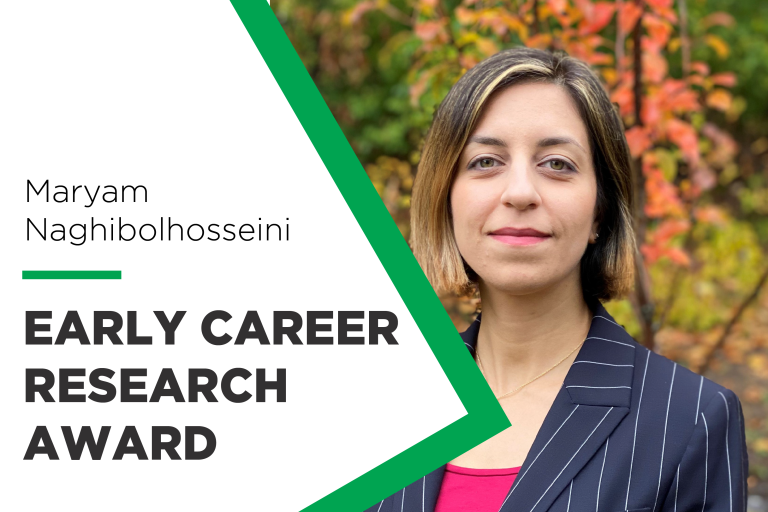
Dr. Maryam Naghibolhosseini is receiving here second award from the NIH
Maryam Naghibolhosseini, Ph.D., recently received a R21 Early Career Research Award from the National Institutes of Health (NIH) National Institute on Deafness and Other Communication Disorders (NIDCD) for her research in structural vocal pathologies. Naghibolhosseini also received the NIH NIDCD K01 Career Development Award back in 2019, making this her second awarded grant from the organization to help fund her groundbreaking research.
Naghibolhosseini is an assistant professor in the department of Communicative Sciences and Disorders and a director of the Analysis of Voice and Hearing Laboratory (AVAH Lab). Naghibolhosseini received her bachelor’s and master's degrees in biomedical and electrical engineering, then obtained her Ph.D. from the department of speech-language-hearing sciences at the Graduate Center of the City University of New York. Naghibolhosseini uses her background in biomedical and electrical engineering to help develop innovative modes of research for her studies.
The NIDCD is just one of the many institutes within the NIH, the federal government’s leading organization supporting biomedical research. The NIDCD was established in 1988 and focuses on conducting research and research training on communication processes. The institute provides opportunities to individual researchers and research institutions looking to understand the various aspects that affect hearing, balance, taste, smell, voice, speech and language. These opportunities can include supporting research grants, career development and training awards.
In Naghibolhosseini’s case, she will use her career research award to study the structural aspects of voice production. When beginning this research, Naghibolhosseini thought of her engineering background as the “tools” to help produce the logistical and scientific methods behind her research ideas. She then applied the skills acquired from her Ph.D. in communication sciences as the inspiration for the research project. This helped her form the questions that would generate ideas for improving the lives of people with voice disorders.
The first grant Naghibolhosseini received from the NIH NIDCD helped her gain more clinical exposure so she could develop methods of studying neurogenic voice disorders. With that experience, she was able to start her research and conduct studies using high-speed video endoscopy that enters through a patient’s nose to take high-speed photos of the larynx.
With the use of the endoscopy, Naghibolhosseini and her team can watch how the vocal folds in the larynx move when a patient talks. Based on these movements, they take measurements that can be associated with certain voice disorders. “The goal is to understand how these disorders affect the functions of the vocal folds,” said Naghibolhosseini.
For her second grant, Naghibolhosseini is using what she describes as “deep learning methods” to help with the research she’s developing this time around. Naghibolhosseini and her team — co-investigators Mohsen Zayernouri, Ph.D., associate professor from the departments of Mechanical Engineering and Statistics and Probability, and Dimitar Deliyski, Ph.D., chairperson of the Department of Communicative Sciences and Disorders — plan to integrate the developed methodologies and acquired knowledge from her previous study to understand anomalies in the structure or tissues of the vocal folds. Taking this data into account, their goal is to develop biomechanical models of voice production.
“The difference between this one and the previous data is that, for this specific grant, we use what we call ‘rigid endoscopy,’” said Naghibolhosseini. A rigid endoscope is placed in a patient’s mouth and can take high-speed photos of the movement and vibrations of the vocal folds. However, based on the nature of this endoscopy, the patient can only produce specific vowel sounds instead of being able to speak in sentences like the first study. Once she and her team collect data of how the vocal folds move, they can plug that data in to a biomechanical model of their own design, which predicts the functions or movements of the different tissues that are involved in voice production.
Using multi-disciplinary tools from engineering, math and science backgrounds “open up new attractive opportunities in the area of voice science, making new discoveries in the laryngeal biomechanics, backed by high-speed videoendoscopic imaging data,” said Zayernouri.
Their main goal is to simplify a very complex process to simulate what is happening in that area of voice production. This way, they can measure the characteristics of the tissues without needing to remove anything from the body for invasive experimental measurements in the lab. This non-invasive approach can save a lot of time when working with patients who have a structural voice disorder. Naghibolhosseini described the benefit of this procedure: “It’s to better understand how an anomaly in the function or structure of the vocal folds affect our voice production mechanism. This is important because this would be very helpful for doing an accurate diagnosis of the vocal folds/voice disorders.”
The research collected through this grant is just one step towards Naghibolhosseini’s main goal to help develop research design models that can predict the outcome of surgeries intended to improve a patient’s voice production. This would ultimately decrease the number of misdiagnoses or unnecessary surgeries people with structural voice disorders might experience when seeking help.
Deliyski is excited to continue working with Naghibolhosseini and seeing how this research progresses. “It is a privilege to be a co-investigator in Dr. Naghibolhosseini's new NIDCD grant. We have a well-established collaboration in the past 7 years resulting in high productivity and multiple funded research grants. Dr. Naghibolhosseini maintains a unique independent research program,” said Deliyski. “I am so much looking forward to this new project and our continued collaboration!”
Story adapted from the Communication Arts and Sciences website.
